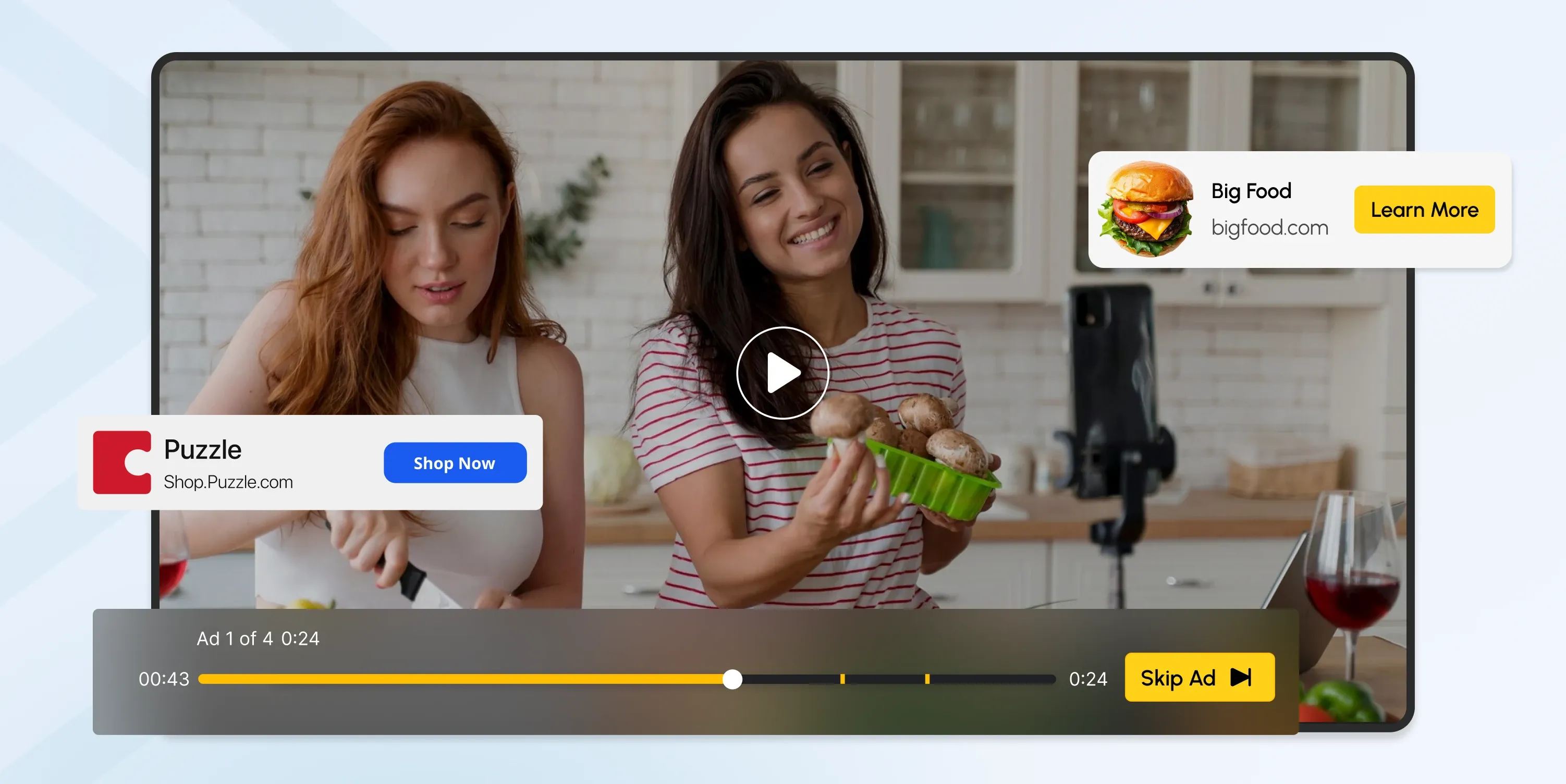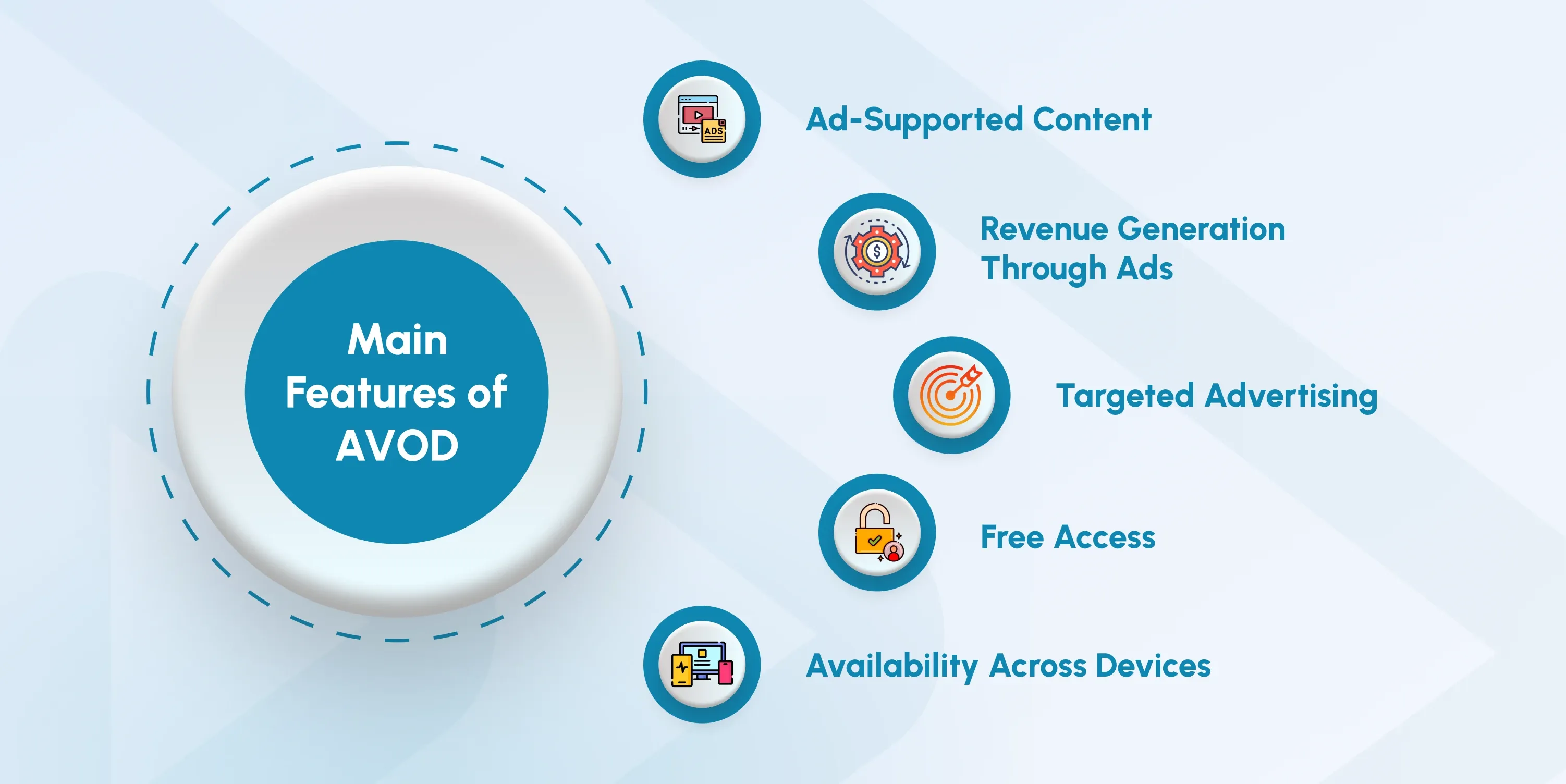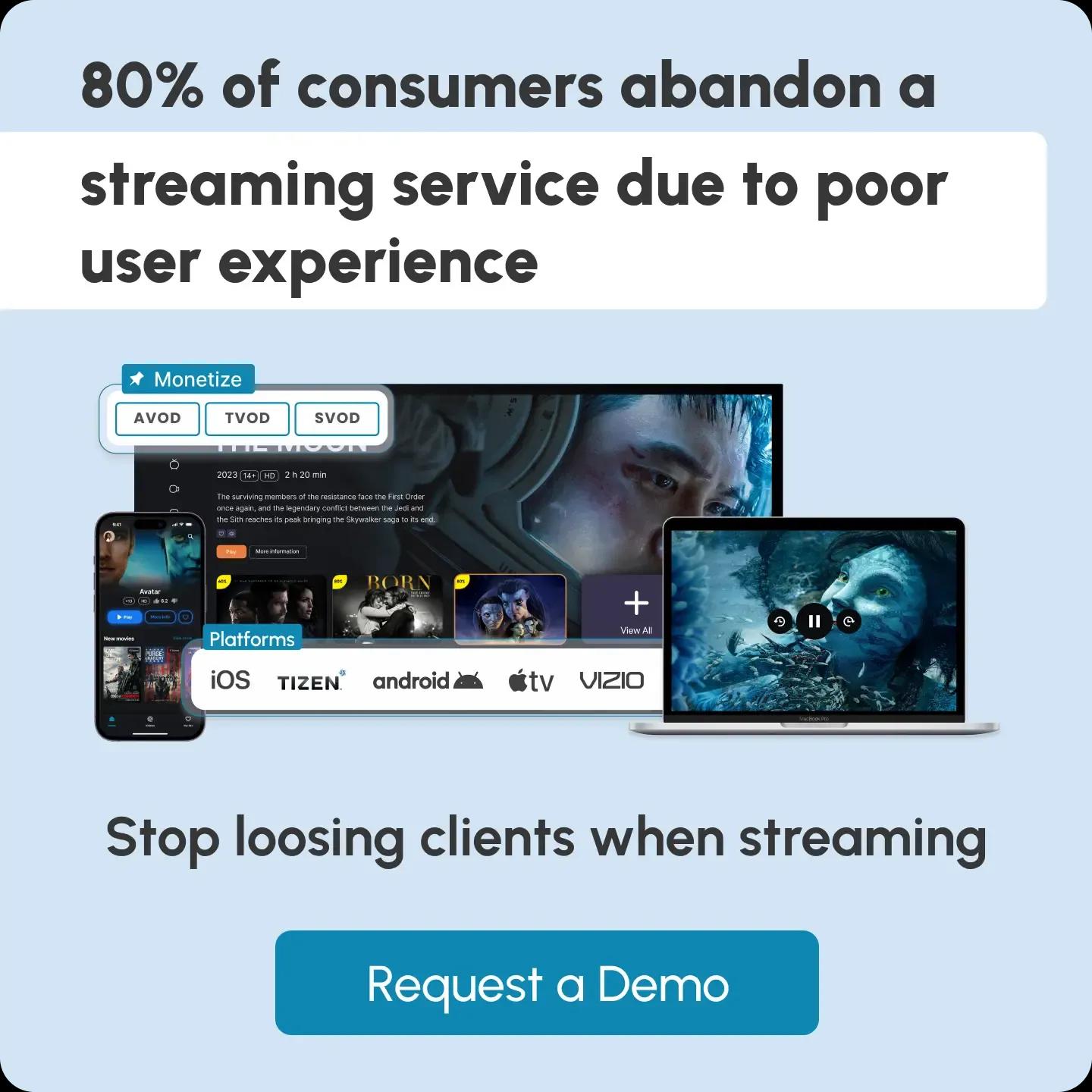
What is AVOD? Definition, Examples, and Monetization Strategies
The concept of AVOD dates back to the early days of streaming, before the rise of giants like Netflix, HBO, and Amazon Prime.
But, what is AVOD?
Advertising video on demand (AVOD) is a streaming model that allows viewers to watch content for free, in exchange for watching ads. AVOD can be a great monetization method if you offer general content and want to reach a broad audience.
Interested? There is more to discover about AVOD. Read on to learn!

What Does AVOD Stand For?
AVOD stands for advertising video on demand, which is a fancy way of saying that it's a streaming model where viewers watch content for free, but with ads sprinkled throughout.
So, what is AVOD in simpler terms? It's a win-win: Viewers get to enjoy their favorite shows and movies without paying a dime, and platforms make money from the ads that play during the content. This helps cover production and hosting costs without charging a subscription fee.
The idea of watching great content for free is pretty appealing, which is why so many people are tuning in to AVOD platforms. To give you an idea, there were over 140 million monthly AVOD viewers in the U.S. by the end of 2023. That number is expected to jump to more than 170 million by 2026.
AVOD Overview
- Viewers enjoy a broad selection of content for free, with ads playing at regular intervals, providing value to both users and platforms.
- Revenue for AVOD platforms comes from advertisements, with targeted ads enhancing effectiveness for advertisers and increasing income for platforms.
- Data analytics play a crucial role in AVOD, enabling platforms to deliver more relevant ads to specific audiences—improving ad performance and viewer engagement.
- AVOD monetization strategies include various ad formats such as pre-roll, mid-roll, and interactive ads, allowing platforms flexibility in how they generate revenue.
- AVOD comes with several challenges, including managing disruptive ads, measuring ad effectiveness, and dealing with unpredictable revenue streams, which require strategic management.
Popular AVOD Examples
One of the biggest AVOD platforms out there is YouTube, with over 2.5 billion active viewers. While it’s free to join and watch videos, you do have to sit through some ads before, during, or after your content. YouTube shares a part of its ad revenue with content creators, encouraging them to keep making videos for the platform.
Besides YouTube, other top AVOD platforms include Tubi, Pluto TV, and Hulu. Hulu, for example, offers both a free, ad-supported plan and a subscription plan for those who prefer an ad-free experience.
Flexibility is part of what makes AVOD so appealing to different types of viewers.
Key Features of AVOD
Now that you know the AVOD definition, let’s dive into some key features that set AVOD apart from other streaming models.

Revenue Generation Through Ads
With AVOD, the primary source of income is advertising. Platforms benefit from ad revenue, while advertisers gain targeted exposure to specific audiences, making their ads more effective.
Targeted Advertising
Top AVOD platforms use data analytics to deliver ads that are more relevant to viewers. This means you’re more likely to see ads that align with your interests and viewing habits.
For advertisers, this targeted approach boosts the effectiveness of their campaigns, making sure they reach the right audience at the right time.
Free Access
The main feature of AVOD is the free access to content. Viewers can enjoy a wide range of shows and movies without paying any subscription fees, which makes AVOD particularly appealing to budget-conscious audiences who still want quality entertainment.
Availability Across Devices
Another great feature of AVOD streaming services is device compatibility. Whether you're on a smartphone, tablet, smart TV, or computer, you can access your favorite content from anywhere at any time, thanks to the convenience and flexibility of the AVOD model.
The 6 Top Benefits of AVOD
If you consider choosing AVOD as a streaming model it is important to know about the advantages it can bring to your streaming platform.
Let’s go through the 6 top benefits:
High Viewership
76% of viewers say they don’t mind watching ads if it means getting free content. This is fantastic news for publishers. With the growing preference for ad-supported content, the AVOD market is projected to reach a revenue of $48.32 billion in 2025 as more viewers opt for this model.
Low Risk for Publishers
Unlike subscription-based services like Netflix or Disney+, AVOD streaming services don't need to invest heavily in creating or purchasing content. Instead, they serve as a platform where content creators can upload their videos, and the platform shares ad revenue with them.
This approach minimizes financial risk while still offering a wide variety of content to viewers.
Incentives for Content Creators
AVOD platforms provide strong financial incentives for content creators. The more viewers engage with their content, the more ads are viewed, resulting in higher income for both the platform and the creators.
This creates a mutually beneficial relationship where both parties profit as viewership grows.
Better Ad Targeting
AVOD offers effective ways for advertisers to reach a large, diverse audience. By leveraging publisher data, AVOD platforms deliver personalized ads that are more relevant to viewers, increasing their impact and effectiveness.
A data-driven approach helps advertisers target their ideal customers more precisely.
Flexibility
This is what AVOD is all about—flexibility in how ads are presented. Publishers can choose different ad formats and decide when to show ads during a stream.
The ability to test and tweak ad placements helps publishers strike the perfect balance between earning ad revenue and keeping viewers happy.
AVOD Monetization: Ad Options for Your Business
Ad options are crucial for AVOD monetization—they provide countless ways for platforms and content creators to generate revenue from ad-supported content.
A mix of ad types can maximize their earnings while keeping viewers engaged and satisfied.
Here are the main types of ads you can use for effective AVOD monetization.
Pre-Roll Ads
Pre-roll ads play before the video starts. Viewers must watch these ads if they want to access the content they’re interested in. This format is effective because viewers are more likely to watch the ad, especially when they’re eager to get to the video. Plus, since pre-roll ads appear before the content begins, they don’t feel as intrusive or tiresome.
Mid-Roll Ads
Mid-roll ads pop up in the middle of a video, creating a brief interruption. These ads can often be skipped after a certain amount of time. For example, YouTube uses both pre-roll and mid-roll ads to maximize engagement.
To make mid-roll ads work well, it’s essential to space them out and avoid making them too frequent. The key is to match the ad frequency to the length of the video, ensuring a good balance between generating revenue and maintaining a positive viewer experience.
Post-Roll Ads
Post-roll ads appear after a video ends, typically when another video is about to start. These ads tend to be less popular because many viewers skip them once they’ve finished watching the main content. However, they can still be effective if used strategically, especially when combined with engaging follow-up content.
Takeover Ads
Takeover ads are displayed on high-traffic pages or sections of a platform, where the advertiser takes over the screen space. This format allows advertisers to place ads over videos or across the website, capturing the attention of viewers who frequent these areas.
Companion Banners
Companion banners run alongside the main content, appearing above, below, or on the sides of a video. They provide extra ad space without interrupting the viewing experience. This type of ad can enhance brand visibility and complement other ad formats on the platform.
In-Video Overlays
In-video overlays are semi-transparent ads that appear at the bottom of a video. They don't pause the content but instead provide a subtle call to action. These overlays can be highly effective for driving engagement without being overly disruptive.
Interactive Ads
Interactive ads invite viewers to engage directly with the ad content, whether through clicking, swiping, or even playing a mini-game. These ads are highly engaging and memorable because they encourage active participation, making them stand out more than the traditional AVOD examples mentioned above.
Key Differences Between SVOD vs. AVOD vs. TVOD
Now that we've covered the AVOD meaning, its purpose, and how it works, let's explore how it differs from other popular monetization models like SVOD (subscription video on demand) and TVOD (transactional video on demand).
Here is a comparison table for an easy vision:
| SVOD vs. AVOD vs. TVOD | SVOD | AVOD | TVOD |
|---|---|---|---|
| Revenue Model | Subscription fees | Free access with ads | Pay per movie or episode |
| Content Access | Unlimited access to the content library | Free access with ads | Pay for individual titles |
| User Experience | Ad-free viewing, usually high-quality content | Ads may interrupt the viewing experience | No ads, but content is individually purchased |
| Device Availability | Available on multiple devices and platforms | Available on multiple devices and platforms | Available on multiple devices and platforms |
| Example | Netflix, Disney+, Amazon Prime Video | YouTube, Tubi, Pluto TV | iTunes, Google Play, Amazon Video |
Challenges Facing AVOD Providers
Although AVOD streaming services have a lot to offer, they don’t come without a few limitations.
Potentially Poor User Experience
If not managed well, ads can disrupt the user experience, potentially leading to a decline in viewership and even causing users to leave the platform.
While some consumers might be willing to pay for a premium, ad-free experience, AVOD providers must get the timing and frequency of ads just right.
Poorly timed or overly repetitive ads can frustrate viewers, prompting them to switch to a different platform.
Attribution and Measurement Challenges
As we know, the passive nature of video streams often makes it challenging for advertisers to measure the true impact of their ads. Unless a user clicks on a call to action (which is unlikely if they’re in the middle of watching something), it’s hard to know if they’re paying attention to the ad.
Uncertain Revenue
What does AVOD mean for revenue generation? Ad-based revenue can be unpredictable for AVOD platforms. Since advertisers often pay based on ad views or clicks, if ads are skippable or viewers aren't genuinely engaged, revenue can be inconsistent.
For a stable income, some publishers may consider offering a subscription option alongside their AVOD model, providing a more reliable revenue stream.
Content Licensing and Acquisition Costs
While AVOD platforms don’t necessarily have to produce original content, they often need to license popular shows and movies to attract viewers.
The cost of acquiring high-quality content can be significant, especially as competition among AVOD streaming services increases. Balancing Content Variety and Ad Load
AVOD platforms should have a diverse content library to keep viewers engaged while managing the ad load to avoid over-commercialization.
Striking the right balance between providing a variety of content and not overwhelming viewers with ads is challenging but essential for maintaining viewer satisfaction and platform credibility.
Future Trends in AVOD
AVOD has experienced significant growth, with Kantar reporting a minimum 20% surge in the US alone between 2021 and 2022.
This upward trajectory is projected to continue in the coming years. Dentsu predicts AVOD streaming services will rival and even surpass SVOD in popularity.
Statista echoes this optimistic outlook, forecasting that the AVOD market will attract 3.4 billion users by 2027. The US is leading the charge, contributing over $24 million to the total revenue in 2024.
With the advertising video-on-demand market growing, we can expect increased personalization and targeted advertising. The more familiar and relevant the ad gets the more the user will engage with it.
Leveraging inoRain for AVOD Solutions
Looking for a reliable partner to elevate your AVOD monetization strategy and drive revenue growth? Look no further—inoRain offers solutions to help your business reach higher levels of success. Whether you're focused on boosting viewer engagement or unlocking new revenue streams, with inoRain you can have the flexibility and efficiency needed to thrive in the AVOD market.
Ready to elevate your streaming and maximize your monetization? Contact us to discover how you can transform your advertising approach with innovative AVOD capabilities!
Conclusion
AVOD has emerged as a major player in the video streaming industry, creating a win-win situation for viewers and content creators.
The potential for growth in the AVOD sector is enormous—making it a critical opportunity for businesses and content creators looking to stay ahead in the future of video consumption.
Frequently Asked Questions
Co-founder / CTO
Armen is the CTO and Co-Founder of inoRain OTT and Co-Founder of HotelSmarters, specializing in advanced streaming technologies, OTT strategy, and interactive TV systems. He builds scalable end-to-end video delivery solutions and drives technical innovation across hospitality and streaming platforms, bridging complex engineering with practical business impact.

How to Develop a Video Streaming App: Best Practices
Learn the basics of developing a modern video streaming app. This guide covers key best practices to help you build the right way from the start.

How to Make a Short Video App (2026 Complete Guide)
Learn how to build a short video app in 2026. Explore micro-drama trends, key features, monetization models, and step-by-step development insights.

OTT Advertising: Types, Best Practices, and Strategies
Over-the-top (OTT) advertising has transformed how brands connect with consumers.

